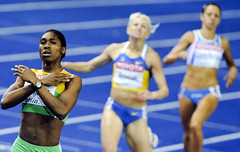
“My good woman, you are a man!”
-

- Caster Semenya crosses the finish line. José Sena Goulão / CC BY-NC-ND 2.0
When South Africa’s Caster Semenya stepped onto the track at the recent World Championships in Athletics for the final round of the women’s 800 meter race, she likely did not imagine that 1:55.45 later, she would be the new world champion. If her win was shocking, the reaction to it must have been even more startling for this girl who grew up in a rural village, running to play soccer with the boys after completing her chores. The questions started almost immediately following the race. First her competitors, then other coaches, and finally the International Association of Athletic Federations (IAAF) itself began questioning whether Semenya’s blazing fast time was legitimate. Yet unlike most modern investigations into athletic competition, this query didn’t involve questions of doping. Instead, the spectacle currently playing out on the international stage concerns something much more elemental and much more complicated: Caster Semenya’s sex.
Semenya is certainly not the first female athlete to have a stride described as masculine. She is not the first to have a body lacking most if not all of the curves that define women who don’t spend hours a day on the track or in the gym. And, although no one has commented on this publicly, if it were the case, she is far from alone amongst the ranks of elite female athletes who become amenorrheic from the demands of their training. Yet the questions about Semenya refuse to go away. “Just look at her,” says the Russian athlete who took fifth in the 800m and publicly questioned Semenya’s ability to pass a sex test. Sour grapes perhaps, and certainly a candid comment not censored for political correctness by the coaches and national federations that trail athletes at such venues. At the same time, however, it is hard to listen to this clip of an interview following the race and not be surprised to learn that the speaker is the women’s champion.
The entire situation has become more complex by the overtones of racism, discrimination, and developed vs. developing world which have entered the equation, but the fundamental question of what defines “male” versus “female” is just as complicated. In the case of the IAAF, the investigation involves a geneticist, endocrinologist, gynecologist, and psychologist, among others. Many of the posts at online forums discussing this case and even quotes from Semenya’s family members demonstrate the commonly held (yet simply incorrect) assumption that this question can be answered by an external examination (or by the recollections of diaper-changing so many years ago). The truth of the matter is that despite binary social constructions, the matter of biological sex is anything but black and white.
Approximately 1 in 2,000 births in the United States involve some degree of gender ambiguity—where it’s not immediately possible to make the delivery room, “It’s a xxx!” pronouncement—which means there are about 65,000 babies born each year in this country alone who fall into the intersex category. At its most elemental, intersex refers to a discrepancy between internal and external genitalia. The way in which this happens makes sense in light of developmental biology: male sex is a product of hormone exposure produced during fetal development. If the right hormone is not produced—or if the developing reproductive system lacks the cellular receptors to respond—development proceeds down the (default) “female” pathway. Together, some combination of these factors is responsible for individuals who don’t fit neatly into “male” or “female” categories due to a discrepancy between internal organs, external organs, and chromosomes.

Yet despite slowly changing practices when it comes to the medical approach to intersex births, what happens in the case of an individual like Caster Semenya? Raised as a girl with every indication that she fully identifies with the female sex, what will happen to this young woman if it turns out that some part of her anatomy or biochemistry does not conform to a biological picture of sex in which internal, external, and chromosomal status all match? Without doubt that question could and should have been asked in a more sensitive and professional manner. Whether or not sex falls along such lines, athletic competitions are black and white, male or female, one or the other. Recent reports indicate that preliminary testing has shown that Semenya’s androgen levels are higher than the norm for most women. But even still, such quantitative laboratory measures lead to only more questions. After all, how much testosterone makes a man? Is such a question ever answerable?
